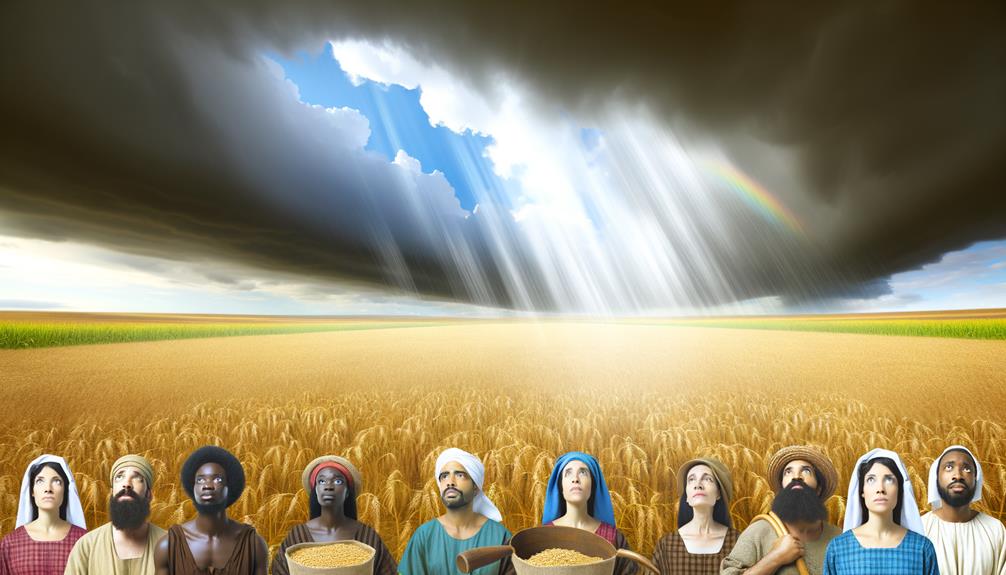Latter Rain Meaning In The Bible: Revival and Blessing
In biblical context, the term ‘latter rain‘ refers to the seasonal spring rains essential for agricultural success in ancient Israel, symbolizing divine blessing and provision (Joel 2:23; Zechariah 10:1). Its metaphorical use extends to spiritual revival and preparation for divine promises as exemplified in prophetic literature.
The cyclical nature of latter rain denotes a period of renewal and fulfillment, critical for both material abundance and spiritual growth. In this way, it underscores themes of continuity in divine intervention and faithfulness, inviting a richer exploration of its theological and eschatological implications.

Latter Rain Meaning in the Bible: Prophetic Outpouring and Spiritual Renewal
| Aspect | Details |
|---|---|
| Term | Latter Rain |
| Biblical References | Joel 2:23, Hosea 6:3, James 5:7 |
| Literal Meaning | Seasonal rain in Israel before harvest |
| Spiritual Symbolism | Holy Spirit outpouring, revival, end-time blessings |
| Old Testament Context | God’s provision and covenant faithfulness |
| New Testament Parallel | Pentecost and future spiritual awakenings |
| Prophetic Significance | Preparation for spiritual harvest and Christ’s return |
Biblical References

How is the concept of the latter rain represented in the Bible, and what significance does it hold within the scriptural context?
The latter rain is primarily referenced in the Book of Joel (Joel 2:23) and the Epistle of James (James 5:7). In Joel, it symbolizes divine blessing and agricultural prosperity, signifying God’s favor and provision.
James employs it metaphorically to illustrate spiritual patience and the anticipated return of Christ.
The latter rain complements the former rain, indicating a cyclical pattern of renewal and growth. This duality underscores a theological theme of continuous divine intervention and fulfillment.
Collectively, these references imbue the latter rain with a dual significance: material abundance and spiritual preparedness, thereby enriching the biblical narrative with layers of meaning.
Historical Context

In exploring the historical context of the latter rain, one must consider the agrarian society of ancient Israel, where seasonal rains were essential for sustaining crops and ensuring survival.
The agricultural calendar was significantly dependent on the early (autumn) and latter (spring) rains. The latter rain, falling in the spring, was vital for the maturation of grain crops, particularly wheat and barley, enabling a successful harvest.
Scriptural references to this meteorological phenomenon reflect its importance in daily life and its role in God’s covenantal promises.
Understanding the timing and significance of these rains provides insight into the socio-economic conditions of the time, highlighting the dependency of ancient Israelites on natural cycles for their sustenance and prosperity.
Metaphorical Significance

The latter rain in the Bible is frequently employed as a metaphor for spiritual revival and divine blessing, reflecting the profound theological implications it holds within the scriptural narrative.
This imagery is rooted in the agricultural cycle of ancient Israel, where the latter rain was essential for the maturation of crops, symbolizing the nurturing and culmination of spiritual growth.
Biblically, it signifies a period of increased spiritual fervor and divine intervention, often preceding significant events or transformations within the community of believers.
This metaphor underscores the necessity of divine sustenance for spiritual maturity, paralleling the natural world’s reliance on seasonal rains.
Consequently, the latter rain metaphor encapsulates the themes of renewal, preparation, and the fulfillment of divine promises.
Prophetic Books

Several prophetic books within the Bible, including Hosea, Joel, and Zechariah, intricately weave the concept of the latter rain into their eschatological and redemptive themes, highlighting its significance in divine prophecy and the ultimate restoration of God’s people.
This imagery of the latter rain represents a divine promise of renewal and abundance, symbolizing a spiritual resurgence and the fulfillment of God’s covenant.
- Hosea: Emphasizes the latter rain as a sign of God’s faithful love and restoration (Hosea 6:3).
- Joel: Associates it with the outpouring of the Spirit and national restoration (Joel 2:23-29).
- Zechariah: Links the latter rain to divine favor and the prosperity of Israel (Zechariah 10:1).
These references collectively underscore the latter rain’s profound theological implications.
Spiritual Renewal

Spiritual renewal, as symbolized by the latter rain in biblical literature, encapsulates a transformative process of divine rejuvenation and moral revival within the faith community.
This metaphorical ‘rain’ signifies a period where believers experience a profound awakening, marked by an intensified relationship with God, moral repentance, and community harmony. The table below illustrates key elements of spiritual renewal:
| Aspect | Description | Biblical Reference |
|---|---|---|
| Divine Rejuvenation | Renewal of spiritual vigor and connection | Joel 2:23-29 |
| Moral Revival | Turning away from sin, embracing righteousness | Hosea 6:1-3 |
| Community Harmony | Strengthening of communal bonds and unity | Acts 2:42-47 |
| Intensified Worship | Deepened acts of worship and praise | Ezekiel 34:26 |
| Prophetic Fulfillment | Realization of prophetic promises | James 5:7-8 |
Period of Blessing

The concept of the latter rain in biblical text is intrinsically linked to a period of blessing characterized by abundant harvests, symbolizing divine favor and provision.
This metaphor extends beyond agricultural prosperity to signify a profound spiritual renewal, underscoring the transformative power of divine intervention in the lives of believers.
Analyzing these points elucidates the multifaceted nature of blessings associated with the latter rain.
Abundant Harvest Symbolism
Rooted in agrarian imagery, the concept of an abundant harvest in biblical texts often symbolizes a period of divine favor and blessings. This symbolism serves as a metaphor for the manifold blessings bestowed by God upon His people during times of covenantal faithfulness.
The imagery of an abundant harvest encapsulates multiple dimensions of divine favor:
- Material Prosperity: Signifies tangible blessings such as bountiful crops and economic stability.
- Spiritual Fulfillment: Reflects the richness of spiritual life and the outpouring of divine grace.
- Community Well-being: Indicates the overall health, unity, and prosperity of the community.
These elements collectively emphasize the holistic nature of divine blessings, transcending mere material wealth to encompass spiritual and communal enrichment.
Spiritual Renewal Significance
A period of blessing, often referred to as spiritual renewal, denotes a profound resurgence of faith and divine favor among the faithful. This concept, deeply rooted in biblical exegesis, is symbolically associated with the ‘latter rain‘—the seasonal rains that guarantee a bountiful harvest in agrarian societies.
Historically, these rains signify God’s providential care and sustenance, paralleling spiritual refreshment and revitalization. Scriptural references, such as in Joel 2:23-29 and James 5:7, underscore this period as one of transformative spiritual awakening, where divine grace fosters growth, repentance, and renewed purpose.
Consequently, the latter rain metaphorically illustrates the outpouring of the Holy Spirit, emphasizing the rejuvenation of the believer’s soul and the collective empowerment of the church community.
God’s Promises

The concept of God’s promises, as related to the latter rain, is intricately linked to the Covenant of Abundance, where divine assurances of blessings are given to the faithful.
These promises are not merely symbolic but serve as tangible manifestations of prophetic fulfillment, reinforcing the certainty of God’s word.
Covenant of Abundance
In the context of the biblical ‘latter rain,’ God’s promises are intricately linked to the Covenant of Abundance, which underscores His commitment to providing spiritual and material blessings to His people.
This covenant is characterized by three primary elements:
- Provision: God guarantees that His followers receive the necessary resources for their sustenance and growth, both materially and spiritually.
- Prosperity: Beyond mere provision, the covenant includes promises of prosperity, where believers experience flourishing in various aspects of life.
- Protection: God promises to safeguard His people from adversities, guaranteeing that they can continue to thrive under His care.
This Covenant of Abundance is a reflection of God’s enduring faithfulness and His desire to see His people flourish in every dimension of life.
Assurance of Blessings
How does the biblical concept of ‘latter rain‘ illustrate God’s unwavering commitment to fulfilling His promises of blessings to His people?
The term ‘latter rain’ in biblical texts, particularly in Joel 2:23 and Zechariah 10:1, symbolizes a period of spiritual renewal and abundant blessings.
This concept serves as a metaphor for Divine assurance, showcasing God’s fidelity to His covenant promises.
The latter rain signifies the outpouring of the Holy Spirit, leading to fruitful harvests both physically and spiritually.
By emphasizing the cyclical nature of rain and harvest, these scriptures affirm that God’s blessings are not sporadic but continuous and reliable.
This reinforces the trustworthiness of His divine promises and the abundance they bring to the faithful.
Prophetic Fulfillment Signs
Numerous scriptural passages underscore the ‘latter rain’ as a tangible indicator of the unfolding of prophetic promises, thereby symbolizing the realization of God’s covenantal assurances.
This metaphorical rain represents spiritual revival and the actualization of divine pledges. The ‘latter rain’ is often seen as a precursor to significant spiritual events and transformative periods.
Key signs of prophetic fulfillment include:
- Increased Spiritual Enlightenment: Individuals experience a deeper understanding of divine truths and biblical revelations.
- Manifestation of Spiritual Gifts: Believers witness a resurgence of spiritual gifts, enhancing communal faith.
- Global Evangelism: The spread of the gospel intensifies, fulfilling the Great Commission as foretold.
These elements collectively illustrate the ‘latter rain’ as a harbinger of imminent divine interventions and promises.
Restoration and Abundance

The concept of the latter rain in the Bible is often interpreted as a divine promise of restoration and abundance, symbolizing a period of spiritual renewal and material prosperity following times of hardship or deprivation.
This theological notion suggests that the latter rain, as described in prophetic scriptures, heralds a rejuvenation of faith and an influx of blessings. The metaphorical rain signifies God’s provision and favor, leading to a flourishing state of being.
| Symbol | Biblical Reference | Interpretation |
|---|---|---|
| Latter Rain | Joel 2:23 | Divine favor and blessing |
| Restoration | Jeremiah 30:17 | Healing and renewal |
| Abundance | Psalm 65:11 | Overflowing provision |
Understanding these elements provides deeper insight into the scriptural assurances of God’s enduring faithfulness.
Cyclical Patterns

Cyclical patterns in biblical texts often underscore the recurrent themes of divine intervention, judgment, and redemption, reflecting the rhythmic nature of God’s relationship with humanity.
These cycles are evident in various scriptural narratives, symbolizing the continual process of spiritual renewal and moral testing. The concept of the ‘latter rain’ fits within these cycles, representing a period of spiritual outpouring and blessing that follows times of drought and hardship.
- Divine Intervention: God intervenes to guide and correct His people.
- Judgment: Consequences are meted out for disobedience and sin.
- Redemption: Restoration and renewal occur through divine grace.
These patterns illustrate the enduring hope and promise inherent in the biblical message, emphasizing the transformative power of faith and repentance.
Conclusion
In summation, the concept of the ‘latter rain‘ in biblical literature is not merely an agrarian metaphor but an intricate tapestry of prophetic promises, spiritual renewal, and divine abundance.
Historical and cyclical patterns underscore its perennial relevance.
Perhaps, in a divine twist, the ‘latter rain’ serves to remind mortals that even in the absence of umbrellas, one can expect a deluge of blessings, provided that faith is as steadfast as the ancients purported it to be.






